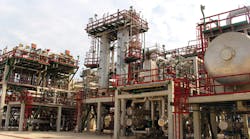It would take Iraq at least 3 years to reach an oil production level of 3.5 million b/d, "and many more years to exceed it," said Issam al-Chalabi, former Iraqi oil minister, at a recent energy conference in Turkey.
"Basically, and without getting into details, Iraq's quota [as a member of the Organization of Petroleum Exporting Countries] today, recognized at parity with Iran, is currently around 3.5 million b/d," said Al-Chalabi. However, he said, "Iraq has no government today and cannot even be represented in OPEC or any other international organizations until a recognized government is installed."
Although still a member of OPEC, Iraq has not been an active participant since 1990 when the United Nations imposed trade sanctions against that country because of its invasion of Kuwait. After allied forces pushed Iraqi troops out of Kuwait in 1991, the UN supervised an oil-for-aid exchange program that allowed Iraq to export about 2 million b/d of oil just prior to the invasion of that country this year by the US-led coalition.
Al-Chalabi noted that some today think that the recent overthrow of Saddam Hussein's administration might open the door for Iraq's withdrawal from OPEC.
However, he said, "This goes against the country's interests and will serve no purpose. In fact, the record shows that since the introduction of the OPEC quota system in 1983, the capacity of Iraq's export facilities was always less than the allocated quota because of wars and sanctions. The only exception was the very short period in the early 1990s after the completion of the second phase of Iraq's pipeline to the Red Sea and prior to Iraq's invasion of Kuwait."
While Iraq's pre-1990 production capacity stood at 3.5 million b/d, he said, production had fallen to 2.7 million b/d prior to last March. "In fact, Iraqi oil exports reached a level of approximately 2.2 million b/d through certain periods of the oil-for-food program," said Al-Chalabi.
Iraq's oil production currently is projected at 300,000-400,000 b/d for the second quarter of this year, less than what was required to meet that country's prewar domestic demand of roughly 500,000 b/d (OGJ Online, June 23, 2003). Plagued by sabotage, interim Iraqi oil officials have given up projecting dates by which they hope to increase production to even 1 million b/d.
"Exactly how strongly Iraq will return to the world markets remains to be seen," said Al-Chalabi. "It is my understanding that if serious efforts are not taken to deal with aging reservoirs and the badly maintained surface facilities, then even this production capacity [of 1.3 million b/d, increasing gradually to 2 million b/d by yearend] might not be reached."
Moreover, Al-Chalabi said, "The state of the downstream industry is in a much worse condition. It remains gasoline oriented, with the fuel oil cuts exceeding 55%. It goes without saying that serious and immediate steps must be taken to rehabilitate and upgrade the refineries while attempting to meet local demand.
"This explains the reasons behind the resumption of fuel oil exports to Jordan and Turkey in return for exchange for LPG and gasoline," he said.
To jump-start Iraq's oil industry again, said Al-Chalabi, "There will be much assistance needed from foreign companies, including service, drilling, construction, and engineering firms. The estimated cost for these programs during this period is around $5 billion."
Al-Chalabi served as Iraq's oil minister from 1980 through October 1990. He is now an industry consultant in the Middle East. He was keynote speaker at an Istanbul conference June 11-13, sponsored by the Cambridge Energy Research Associates.
